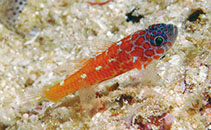| Family: |
Gobiidae (Gobies), subfamily: Gobiinae |
| Max. size: |
2.94 cm SL (male/unsexed) |
| Environment: |
demersal; marine; depth range 5 - 30 m |
| Distribution: |
Western Pacific: Australasian plate and the Solomon Islands. |
| Diagnosis: |
Dorsal spines (total): 7-7; Dorsal soft rays (total): 7-9; Anal spines: 1-1; Anal soft rays: 5-5. Diagnosis: a frontal ridge behind the orbits that slopes steeply into a wide interorbital trench
anteromedially, and into postorbital trenches laterally; posterior nasal opening separate from anterior margin of eye; second spine of first dorsal elongate, third spine not elongate; fifth pelvic fin ray branched once dichotomously; body color on anterior half off-white, grey anteriorly with grey-blue snout, red-orange trunk grading to yellow caudally, with five white dorsolateral spots between peduncle and origin of first dorsal, and two white ventrolateral spots between the peduncle and anal fin; a red-orange bar and two irregular blotches under orbit; slightly darkened posterior margin of pectoral base (Ref. 57688). |
| Biology: |
Solitary, often resting on sand or rubble bottoms of caves and ledges in 5-30 m (Ref. 90102). |
| IUCN Red List Status: |
Least Concern (LC); Date assessed: 11 March 2015 Ref. (130435)
|
| Threat to humans: |
harmless |
Source and more info: www.fishbase.org. For personal, classroom, and other internal use only. Not for publication.

